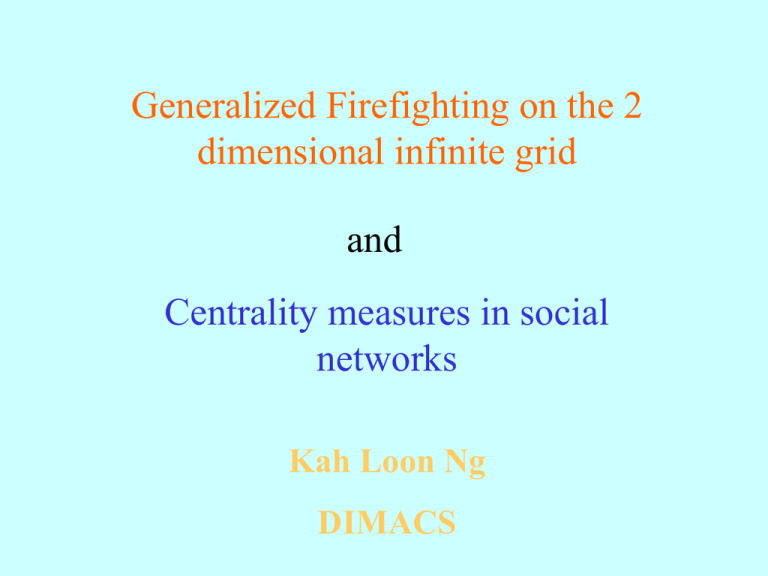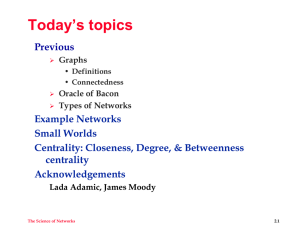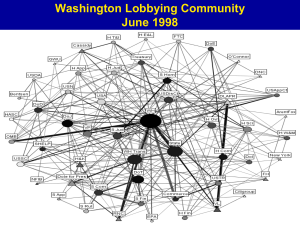Generalized firefighting on the 2 dimensional infinite grid and centrality measures in social networks
advertisement

Generalized Firefighting on the 2 dimensional infinite grid and Centrality measures in social networks Kah Loon Ng DIMACS Containing fires in infinite grids Ld Fire starts at only one vertex: d= 1: Trivial. d = 2: Impossible to contain the fire with 1 firefighter per time step Containing fires in infinite grids Ld d = 2: Two firefighters per time step needed to contain the fire. 8 time steps 18 burnt vertices Containing fires in infinite grids L2 • We assume that the number of firefighters available for deployment is given by a function f (t ) that is periodic. Justification for considering periodic functions: t 1 1 t 2 t 3 t 4 t 5 t 6 1 2 1 1 2 Containing fires in infinite grids L2 Given a periodic function f , let p f = period of f pf N f f (i ) i 1 Nf Rf pf For example, 1 f (x ) 2 3 if x 1 mod 3 if x 2 mod 3 if x 0 mod 3 (1,2,3,1,2,3,...) We also write f [1,2,3] Nf 6 Rf 2 Containing fires in infinite grids L2 Given positive integers n and k , we define a periodic function g n ,k n 1 [1,1,1,... 1,k ] Given two periodic functions f and g with periods p f and p g respectively, we say n f ( i ) n g (i ) f g n i 1 i 1 n n f ( i ) g ( i ) n lcm( p f , p g ) i 1 i 1 Containing fires in infinite grids L2 If f is a periodic function and i is any positive integer, define the translate function f i by f i ( x ) f ( x i ) For example, if f [1,1,2,2,3] (1,1,2,2,3,1,1,2,2,3,...) and i 3 then f 3 [2,3,1,1,2] ( 2,3,1,1,2,2,3,1,1,2,...) Note that p f i p f N f i N f R f i R f Containing fires in infinite grids L2 Given a positive integer n , let M n be the function with period n defined by n1 M n [1,1,1,... 1, ] where n2 2 Note that is chosen to be the smallest integer such that RM n 1.5 . Define Dn to be the periodic function of period 2n 1 n Dn [1,1,...,1, 2 ,2 ,..., 2] n 1 Containing fires in infinite grids L2 Main Theorem: If the number of firefighters available for deployment per time step can be represented by a periodic function f such R f 1.5 , then any fire that breaks out at a single vertex in L2 can be contained after some finite time t . Lemma 0: Suppose f and g are two periodic functions such that f g . If any fire breaking out at a single vertex in L2 can be contained “using f ” , then it can also be contained “using g ”. Containing fires in infinite grids L2 Proof of Lemma 0: Let s lcm( p f , p g ) . Case 1: If f (i ) g (i ) for all 1 i s , we are done. Case 2: If f (k ) g (k ) for some k 2 . Let k * be the smallest such k . x f (k * ) g (k * ) k * 1 Since f g, we have g (i ) f (i ) x . i 1 Time 1 to k * 1 : Deploy firefighters as in f , and accumulate at least x “spare” firefighters. Containing fires in infinite grids L2 Outline proof of Main Theorem: Given any periodic function f with R f 1.5 “Rearrange” f to get f ' that is non decreasing in its period. [2,3,1,4,1,2] [1,1,2,2,3,4] Lemma 1: f' g p f ,( N f p f 1) [1,1,2,2,3,4] [1,1,1,1,1,8] Mp [1,1,1,1,1,8] [1,1,1,1,1,5] g p f ,( N f p f 1) f Containing fires in infinite grids L2 Outline proof of Main Theorem: [1,1,1,1,1,8] Mp [1,1,1,1,1,5] g p f ,( N f p f 1) Lemma 4: f 35 M pf [1,1,1,1,1,5] D( p f )2 [1 ,1 ,..., 1 , 2 , 2 ,..., 2 ] 36 37 1,1,1,1,5, 1,1,1,1,5, ………1,1,1,1,5,1,1,1,1,5,1,1,1,1,5,…… 1,1,1,1,1,………………………….1,1,2,2,…………………. 36 Containing fires in infinite grids L2 Outline proof of Main Theorem: D( p ) ,1 ,..., ,2 ,..., [1,1,1,1,1,5] [1 1, 2 2] Lemma 4: M pf 2 f 36 37 Lemma 2: If f is a periodic function that is non decreasing over its period, then for any positive integer i , f i f . f 1, 1, 2, 2, 3, 1, 1, 2, 2, 3,… f 2 2, 2, 3, 1, 1, 2, 2, 3, 1, 1,… Gain Loss Containing fires in infinite grids L2 Outline proof of Main Theorem: D( p ) ,1 ,..., ,2 ,..., [1,1,1,1,1,5] [1 1, 2 2] Lemma 4: M pf 2 f 36 37 Lemma 3: If f is a periodic function that is non decreasing over its period, then for any periodic function g with p g p f k k i 1 i 1 satisfying g (i ) f (i ) k k i 1 i 1 for 1 k p g , we have f g . In other words, g (i ) f (i ) for 1 k lcm,( p f , p g ) 1,1,1,1,1,5,…..…….1,1,1,1,1,5, 1,1,1,1,1,5,………..1,5,1,1,1,.. 1,1,………………………….,1, 2,2,…………………,2,2,1,1,.. 36 37 Containing fires in infinite grids L2 n n1 The strategy using Dn [1,1,...,1, 2,2,..., 2] End of phase 2 End of phase 1 End of phase 3 Advance firefighters Retreat firefighters Containing fires in infinite grids L2 The strategy using Dn : D6 [1,1,1,1,1,1,2,2,2,2,2,2,2] Completing phase 1: 12 12 11 2 10 10 9 4 8 8 7 6 1 3 5 7 9 11 Containing fires in infinite grids L2 The strategy using Dn : “Delayed response” – Phase 1 can still be completed. Containing fires in infinite grids L2 The strategy using Dn : Completing phase 2 after phase 1 has been completed: (0,0) (0,0) Containing fires in infinite grids L2 The strategy using Dn : Completing phase 3 after phase 2 has been completed: (0,0) (0,0) Containing fires in infinite grids L2 The strategy using Dn : Finishing the job: (0,0) 2 Retreat firefighters Active vertices (0,0) 1 3 4 Containing fires in infinite grids L2 A few points to note: Our theorem says nothing about periodic functions f where R f 1.5 . In fact, we can easily construct a function g where Rg 1 and still g is sufficient to contain the outbreak. (0,0) Containing fires in infinite grids L2 A few points to note: Our theorem says nothing about periodic functions f where R f 1.5 . In fact, we can easily construct a function g where Rg 1 and still g is sufficient to contain the outbreak. 1] is sufficient to contain the outbreak but Obviously, [4,1,1,1,......, we do not consider such (cheating! ) situations. The exact time required to contain the outbreak (and thus the number of burnt vertices) can be explicitly computed as a function of n . However, our strategy does not guarantee that the number of burnt vertices is minimized. Centrality Measures in Graphs (or Social Networks) • Centrality = Importance = Prominence? • 3 types of centrality indices: • degree • betweeness • closeness Centrality Measures in Graphs (or Social Networks) • Centrality indices can be computed for each vertex or a group of vertices. • Majority of centrality concepts are based on non-directed and dichotomous relations • However, for some specific purposes (for example, measuring prestige) directed graphs or valued relations might need to be used. Centrality Measures in Graphs (or Social Networks) Ca ( ni ) = centrality index for vertex ni under measure a a = D, degree measure a = C, closeness measure a = B, betweeness measure n Ca (Ca ( n ) Ca ( ni )) * i 1 n max (Ca ( n* ) Ca ( ni )) i 1 Centrality Measures in Graphs (or Social Networks) CD (ni ) (degree centrality) CD (ni ) = deg( ni ) = degree of vertex ni CD ' (ni ) = n CD 1 deg ( ni ) n 1 n (C D ( n ) C D ( ni )) * i 1 n max (C D ( n ) C D ( ni )) * * ( C ( n D ) CD ( ni )) i 1 ( n 1)( n 2) i 1 n S D2 2 ( C ( n ) C ) D D i i 1 n Centrality Measures in Graphs (or Social Networks) CC (ni ) (closeness centrality) n CC (ni ) ( d (ni , n j )) 1 j 1 CC ' ( ni ) n 1 n d ( ni , n j ) ( n 1)CC ( ni ) j 1 n CC (CC ' ( n ) CC ' ( ni )) n * i 1 n max (CC ' ( n ) CC ' ( ni )) i 1 * * ( C ( n C ) CC ( ni )) i 1 ( n 2)( n 1) /(2n 3) Centrality Measures in Graphs (or Social Networks) CC (ni ) (closeness centrality) • Closeness centrality measures are related to: • Jordan centers of a graph (subset of V (G) with the smallest eccentricities) • Centroid of a graph (subset of V (G) with the smallest “weight”) • One shortcoming of closeness measures is that it cannot be used for disconnected graphs. Centrality Measures in Graphs (or Social Networks) CB ( ni ) (betweeness centrality) Let g jk = number of distinct shortest paths between j and k g jk ( ni ) = number of distinct shortest paths between j and k that passes through ni CB ( ni ) g jk ( ni ) / g jk j k C B ' ( ni ) For each j k , maximum value is 1. g jk ( ni ) / g jk j k n 1 2 n CB * (C B ' ( n ) C B ' ( ni )) i 1 n 1 Centrality Measures in Graphs (or Social Networks) CB ( ni ) (betweeness centrality) • We assume here that if some information (or disease) is passed from j to k , each of the shortest paths is equally likely to be chosen. • If we sum g jk ( ni ) / g jk over all k , we obtain measures of the pair-dependency of vertex j on vertex i . These values can also be viewed as indices of how much “gate keeping” ni does for n j . • CB ( ni ) seems to be an improvement over CD ( ni ) and CC ( ni ) but there are still inadequacies. Centrality Measures in Graphs (or Social Networks) GINORI LAMBERTESCHI ALBIZZI GUADAGNI PAZZI SALVATI TORNABUONI BISCHERI MEDICI RIDOLFI STROZZI ACCIAIUOLI PERUZZI BARBADORI CASTELLANI Centrality Measures in Graphs (or Social Networks) CD ' (ni ) CC ' (ni ) CB ' ( ni ) Acciaiuoli 0.071 0.368 0.000 Albizzi 0.214 0.483 0.212 Barbadori 0.143 0.438 0.093 Bischeri 0.214 0.400 0.104 Castellani 0.214 0.389 0.055 Ginori 0.071 0.333 0.000 Guadagni 0.286 0.467 0.255 Lamberteschi 0.071 0.326 0.000 Medici 0.429 0.560 0.522 Pazzi 0.071 0.286 0.000 Peruzzi 0.214 0.368 0.022 Ridolfi 0.214 0.500 0.114 Salvati 0.143 0.389 0.143 Strozzi 0.286 0.438 0.103 Torabuoni 0.214 0.483 0.092 Centrality Measures in Graphs (or Social Networks) CD ' (ni ) CC ' (ni ) CB ' ( ni ) Acciaiuoli 0.071 0.368 0.000 Albizzi 0.214 0.483 0.212 Barbadori 0.143 0.438 0.093 Bischeri 0.214 0.400 0.104 Castellani 0.214 0.389 0.055 Ginori 0.071 0.333 0.000 Guadagni 0.286 0.467 0.255 Lamberteschi 0.071 0.326 0.000 Medici 0.429 0.560 0.522 Pazzi 0.071 0.286 0.000 Peruzzi 0.214 0.368 0.022 Ridolfi 0.214 0.500 0.114 Salvati 0.143 0.389 0.143 Strozzi 0.286 0.438 0.103 Torabuoni 0.214 0.483 0.092 Some observations Strozzi family has high degree centrality but low closeness centrality. Centrality Measures in Graphs (or Social Networks) CD ' (ni ) CC ' (ni ) CB ' ( ni ) Acciaiuoli 0.071 0.368 0.000 Albizzi 0.214 0.483 0.212 Barbadori 0.143 0.438 0.093 Bischeri 0.214 0.400 0.104 Castellani 0.214 0.389 0.055 Ginori 0.071 0.333 0.000 Guadagni 0.286 0.467 0.255 Lamberteschi 0.071 0.326 0.000 Medici 0.429 0.560 0.522 Pazzi 0.071 0.286 0.000 Peruzzi 0.214 0.368 0.022 Ridolfi 0.214 0.500 0.114 Salvati 0.143 0.389 0.143 Strozzi 0.286 0.438 0.103 Torabuoni 0.214 0.483 0.092 Some observations Tornabouni family has high closeness centrality but low betweeness centrality. Centrality Measures in Graphs (or Social Networks) CD ' (ni ) CC ' (ni ) CB ' ( ni ) Acciaiuoli 0.071 0.368 0.000 Albizzi 0.214 0.483 0.212 Barbadori 0.143 0.438 0.093 Bischeri 0.214 0.400 0.104 Castellani 0.214 0.389 0.055 CD 0.257 Ginori 0.071 0.333 0.000 CC 0.322 Guadagni 0.286 0.467 0.255 CB 0.437 Lamberteschi 0.071 0.326 0.000 Medici 0.429 0.560 0.522 Pazzi 0.071 0.286 0.000 Peruzzi 0.214 0.368 0.022 Ridolfi 0.214 0.500 0.114 Salvati 0.143 0.389 0.143 Strozzi 0.286 0.438 0.103 Torabuoni 0.214 0.483 0.092 Some observations Centrality Measures in Graphs (or Social Networks) Eigenvector centrality “The centrality of a vertex does not depend on the number of vertices it is adjacent to, but also these vertices’ centrality.” Bonacich (1972) defines (eigenvector) centrality CE (ni ) as a positive scalar multiple of the sum of “adjacent” centralities: n CE (ni ) aij CE (n j ) j 1 In matrix form, if C (CE (n1 ),...,CE (nn ))T we have AC C (Perron-Frobenius) Since A is nonnegative, there exists an eigenvector of the maximal eigenvalue with only nonnegative entries. Centrality Measures in Graphs (or Social Networks) Information centrality Adopts the idea that information is passed along the network along all possible paths, not necessary the shortest one. Flow betweenes centrality The flow betweeness of vertex i is defined as the amount of flow through vertex i when the maximum flow is transmitted from s to t , averaged over all s and t . Random walk betweenes centrality The random walk betweeness of a vertex i is the number of times that a random walk starting at s and ending at t passes through i along the way. Centrality Measures in Graphs (or Social Networks) Different measures for different types of flow • Used goods (eg books) – consider trails in graphs? • Money (eg a dollar note) – consider walks in graphs? Markov process? • Attitude/Belief – Influence process • Gossip and infection – similarities and differences • Package delivery – known destination? Shortest route? Paths vs. Walks vs. Trails Transfer vs. Duplication Centrality Measures in Graphs (or Social Networks) Some references: • Freeman L.C. (1979): Centrality in social networks: Conceptual clarification. Social Networks 1, 215-239. •Bonacich P. (1991): Simultaneous group and individual centralities. Social Networks 13, 155-168 •Friedkin N. E. (1991): Theoretical foundations for centrality measures. Amer. Journal of Sociology 96, 1478-1504 •Stephenson K., Zelen M. (1989): Rethinking centrality:methods and examples. Social Networks 11, 1-37. •Borgatti S.P. (2005): Centrality and network flow. Social Networks 27, 55-71. • Ruhnau B. (2000): Eigenvector centrality – a node centrality? Social Networks 22, 357-365 •Faust K. (1997): Centrality in affiliation networks. Social Networks 19, 157-191. •Newman M. (2005): A measure of betweeness centrality based on random walks. Social Networks 27, 39-54. • Bell D., Atkinson J., Carlson J. (1999): Centrality measures for disease transmission networks. Social Networks 21, 1-21.




